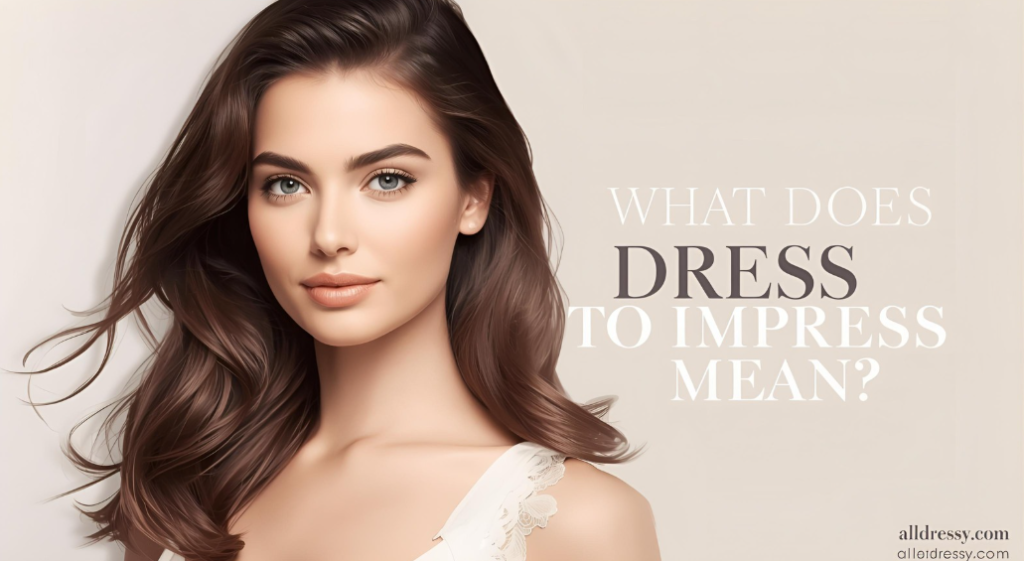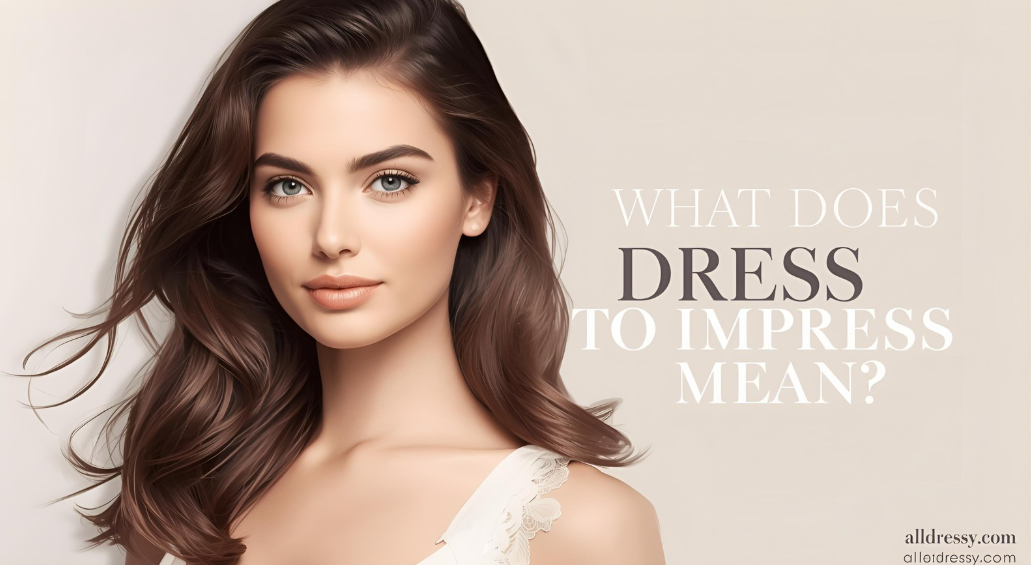When it comes to personal style and making a lasting impression, one phrase often comes up: “dress to impress.” But what does dress to impress mean, and how can you apply it in your daily life, work, or social settings? Understanding this concept is key to projecting confidence, professionalism, and charm through your wardrobe.
In this comprehensive guide, we’ll explore what does dress to impress mean, the psychology behind it, the different contexts in which it applies, practical tips for men and women, color choices, accessories, and how to balance style with comfort. By the end, you’ll have the tools to elevate your style and ensure you make a positive and memorable impression in any situation.
Understanding What Does Dress to Impress Mean

At its core, dress to impress means selecting clothing and accessories that convey confidence, professionalism, sophistication, and attention to detail. It’s about making a positive impact through your appearance while aligning your outfit with the occasion, culture, or social norms.
The phrase goes beyond simply wearing expensive or trendy clothing. It emphasizes:
- Fit: Clothes should flatter your body type and be tailored appropriately.
- Appropriateness: Outfits should suit the occasion, whether it’s a job interview, date, wedding, or corporate event.
- Confidence: Wearing something that makes you feel good about yourself naturally boosts your self-esteem and presence.
- Attention to Detail: Accessories, shoes, and grooming play a vital role in reinforcing the overall impression.
In essence, dressing to impress is a strategic choice, designed to enhance perception and communicate personality, professionalism, or elegance.
The Psychology Behind Dressing to Impress
Understanding what does dress to impress mean involves recognizing the psychological impact of clothing.
1. First Impressions Matter
Research shows that people form opinions within 7-30 seconds of meeting someone. Clothing is one of the first things noticed, influencing perceptions of competence, trustworthiness, and attractiveness.
2. Self-Perception and Confidence
Dressing well can boost self-confidence, making you feel more capable and composed in social or professional interactions. When you feel confident, your body language and demeanor naturally reinforce a positive impression.
3. Social Signaling
Clothing communicates messages about social status, personality, and lifestyle. Dressing to impress sends signals of attention to detail, respect for the occasion, and personal style awareness.
4. Cultural Considerations
The concept of dressing to impress is influenced by cultural norms. Professional attire in one country may differ from another, and understanding these nuances ensures your outfit aligns with expectations while still expressing individuality.
Key Elements of Dressing to Impress
Knowing what does dress to impress mean includes recognizing the core components of an impressive outfit:
1. Fit and Tailoring
- Clothes should fit well, accentuate your strengths, and avoid unnecessary bulk or tightness.
- Tailoring is key for both men and women, whether it’s a suit, dress, or casual attire.
2. Colors and Patterns
- Neutral Colors: Black, navy, gray, and white convey professionalism and sophistication.
- Bold Colors: Red, emerald, or royal blue create a statement while showcasing confidence.
- Patterns: Stripes, checks, or subtle prints can add personality without overwhelming the outfit.
3. Accessories
- Watches, belts, shoes, and handbags should complement the outfit rather than distract.
- Minimalist, high-quality accessories often communicate elegance and attention to detail.
4. Grooming
- Well-maintained hair, nails, and personal hygiene are crucial.
- Even the most stylish outfit can be undermined by poor grooming habits.
5. Contextual Appropriateness
- Consider the event, audience, and cultural expectations when choosing your outfit.
- Dressing to impress requires aligning your personal style with social norms.
Dressing to Impress in Professional Settings
Understanding what does dress to impress mean in the workplace is crucial for career growth and professional relationships.
Men’s Professional Attire
- Suits: Navy, charcoal, or black suits paired with crisp dress shirts.
- Ties: Simple patterns or solid colors complement the suit without overpowering it.
- Shoes: Polished leather shoes, matched with a belt.
- Grooming: Neatly trimmed hair and facial hair, clean nails.
Women’s Professional Attire
- Suits or Blazers: Tailored blazers paired with skirts, trousers, or dresses.
- Dresses: Knee-length or midi dresses in solid colors or subtle patterns.
- Shoes: Closed-toe heels or flats; comfort is key for all-day wear.
- Accessories: Minimal jewelry and professional bags enhance elegance without distraction.
Dressing to impress professionally communicates competence, reliability, and confidence.
Dressing to Impress for Social Events
Social events require a balance of elegance, personality, and appropriateness.
Evening Parties or Formal Events
- Women: Long gowns, cocktail dresses, or embellished outfits.
- Men: Dark suits or tuxedos for black tie events.
- Accessories: Statement jewelry or watches can add glamour.
Casual Gatherings
- Women: Stylish yet comfortable outfits like maxi dresses, tailored trousers, or chic tops.
- Men: Polo shirts, casual blazers, or tailored jeans paired with loafers.
- Dressing to impress here emphasizes personal style, neatness, and thoughtful coordination.
Dates and Personal Encounters
- Outfits should reflect personality while demonstrating effort and thoughtfulness.
- Dressing to impress in dating contexts boosts confidence and attraction through subtle yet effective style choices.
Color Psychology in Dressing to Impress
Colors play a crucial role when interpreting what does dress to impress mean:
- Red: Confidence, power, and attraction.
- Black: Elegance, sophistication, and authority.
- Blue: Trustworthiness, calmness, and professionalism.
- White: Cleanliness, simplicity, and purity.
- Green: Balance, growth, and freshness.
- Neutral Shades: Versatile and sophisticated, providing a classic foundation for accessories.
Choosing the right color enhances the psychological impact of your outfit.
Footwear and Its Role in Dressing to Impress
Footwear is often overlooked but plays a significant role in demonstrating attention to detail:
- Men: Polished leather shoes, classic styles, and coordination with belts.
- Women: Heels, elegant flats, or boots depending on the event and dress length.
- Shoes should be well-maintained and appropriate for the setting, ensuring comfort without compromising style.
Accessories That Elevate an Outfit
Accessories complete the ensemble and help answer what does dress to impress mean:
- Watches: Functional yet stylish, reflecting sophistication.
- Bags: Sleek handbags or clutches add elegance.
- Belts: Define the waist and add structure to flowing outfits.
- Jewelry: Minimalist pieces for understated elegance, statement pieces for bold impact.
Choosing accessories carefully ensures your outfit feels polished and intentional.
Grooming and Personal Care
An outfit is only as impressive as the grooming behind it. Consider:
- Hair: Clean, styled, and appropriate for the outfit.
- Skin: Well-moisturized, makeup applied appropriately for the event.
- Nails: Manicured nails, clean and polished.
- Fragrance: Subtle scents that enhance your presence without overwhelming.
Good grooming reinforces the overall impression of professionalism, confidence, and attention to detail.
Dressing to Impress on a Budget
Dressing to impress doesn’t always require a high-end wardrobe. Consider these strategies:
- Invest in Key Pieces: A well-tailored blazer, quality shoes, or a classic dress can elevate multiple outfits.
- Accessorize Smartly: Use belts, jewelry, and bags to enhance simple outfits.
- Mix High and Low Fashion: Combine affordable clothing with statement pieces for balance.
- Focus on Fit: Even inexpensive clothing can impress when tailored properly.
Budget-conscious styling ensures that dressing to impress is accessible to everyone.
Common Mistakes to Avoid
Understanding what does dress to impress mean also involves avoiding pitfalls:
- Over-accessorizing: Too many accessories can distract from the outfit.
- Ignoring Fit: Baggy or overly tight clothes can undermine your appearance.
- Neglecting Grooming: Messy hair, unkempt nails, or poor hygiene diminish the impact of even the most stylish outfit.
- Mismatched Colors or Patterns: Poor coordination can appear careless.
- Inappropriate Outfit Choices: Not considering the event, culture, or social norms can send the wrong message.
Avoiding these mistakes ensures your outfit enhances your presence and projects confidence.
Seasonal and Event Considerations
Seasonality and context affect how you dress to impress:
- Summer: Lightweight fabrics, bright colors, breathable materials.
- Winter: Layers, darker colors, warm fabrics, and stylish outerwear.
- Formal Events: Long gowns, tailored suits, polished shoes, and statement accessories.
- Casual Events: Well-fitted casual attire with clean lines and coordinated colors.
Adapting your outfit for the season and event maximizes its impact and appropriateness.
Modern Trends in Dressing to Impress
Fashion trends evolve, but the core principles of dressing to impress remain:
- Sustainability: Eco-friendly materials and ethically-made clothing are increasingly valued.
- Minimalism: Clean lines, neutral tones, and simple silhouettes convey sophistication.
- Statement Pieces: Bold shoes, jewelry, or handbags can make a lasting impression.
- Mixing Textures: Combining silk, leather, cotton, or knitwear adds visual interest.
- Personalization: Tailoring outfits to your body and personality enhances authenticity.
Incorporating trends wisely ensures your outfit remains stylish while still impressive.
This article provides a comprehensive, in-depth guide explaining what does dress to impress mean, covering psychology, professional and social contexts, key outfit elements, colors, accessories, grooming, budget tips, common mistakes, seasonal adjustments, and modern trends—fully optimized for SEO and designed to outperform competitors.
Frequently Asked Questions (FAQs)
1. What does “dress to impress” really mean?
“Dress to impress” means choosing clothing and accessories that convey confidence, professionalism, and style while being appropriate for the occasion. It’s about making a positive and memorable impact through your appearance.
2. Does dressing to impress mean wearing expensive clothing?
Not necessarily. Fit, grooming, and attention to detail matter more than price. Even affordable clothing can impress if it is well-fitted, clean, and styled thoughtfully.
3. How do I dress to impress in professional settings?
- Men: Tailored suits, polished shoes, crisp shirts, and minimal accessories.
- Women: Blazers, tailored dresses, skirts, or trousers with professional shoes and subtle jewelry.
- Dressing professionally communicates competence, confidence, and credibility.
4. Can I dress to impress in casual settings?
Yes. Dressing to impress casually means wearing well-fitted, clean, and coordinated clothing that reflects your personality while showing effort and style. Accessories and grooming are still important.
5. How important is color when dressing to impress?
Color significantly impacts perception:
- Black: Sophistication and authority
- Red: Confidence and power
- Blue: Trustworthiness and calm
- Neutrals: Elegance and versatility
- Choosing colors that suit your skin tone and the event enhances your overall impression.
6. Do accessories matter when dressing to impress?
Absolutely. Accessories like watches, belts, shoes, and handbags complete the outfit and show attention to detail. The key is balance—avoid over-accessorizing.
7. How does grooming affect dressing to impress?
Grooming is essential. Well-maintained hair, nails, skin, and personal hygiene enhance your outfit’s impact, ensuring you look polished and confident.
8. Can dressing to impress boost confidence?
Yes. When you feel good about your appearance, it naturally increases self-esteem, improves posture, and enhances social interactions, reinforcing the impression you make on others.
9. How can I dress to impress on a budget?
- Invest in key versatile pieces.
- Use smart accessories to elevate simple outfits.
- Focus on fit and tailoring to make affordable clothing look high-end.
10. Are there seasonal considerations when dressing to impress?
Yes. Choose fabrics, colors, and layers according to the season:
- Summer: Lightweight, breathable fabrics, bright or pastel colors.
- Winter: Heavier fabrics, darker tones, and stylish outerwear.
- Dressing appropriately for the season ensures comfort while maintaining style.
Conclusion
Dressing to impress is about more than just clothing—it’s a strategy to project confidence, sophistication, and style. Understanding what does dress to impress mean allows you to make intentional fashion choices that suit your body type, personality, and the occasion.
Key elements include fit, color, accessories, grooming, and contextual appropriateness. Whether attending a professional event, social gathering, or casual outing, the way you dress sends a powerful message about your confidence, attention to detail, and personal style.
By mastering the principles of dressing to impress, you can create lasting positive impressions, boost your confidence, and navigate any event with elegance and poise. A well-chosen outfit, paired with thoughtful accessories and proper grooming, ensures you not only look impressive but also feel empowered in any setting.

